Friday Afternoon September 19, 2014
Mammoth Cave National Park
Mammoth Cave, Kentucky
This afternoon we walk back over to the visitor center shelter to meet our guide for the Great Onyx Lantern Tour. I am my very happiest when I can camp in the park and walk or bike to everything I want to do. So this is great.
The Great Onyx Cave is a remote area of the cave system and one that is not known to be connected to Mammoth Cave. We take a 20 minute bus ride to get there. Outside the entrance, before we enter, our main guide, Kennetha, again tells us the rules, don’t touch, no flash, decontamination mat at the end and so on.
A wonderful thing, I think, about the cave is that there are no artificial lights in the cave. You couldn’t turn on the lights if you wanted to. Our guides light lanterns for us, one to a party, and Kennetha leads us into the dark. Seeing the cave by lantern light makes us feel like we are on one of the original tours and seeing it just as they did. This tour is only given in the fall and only once a day to lower the impact of human activity. I am grateful for that too and doubly grateful that we are here at the right time to see it.
When she opens the door, there are cave crickets and a tiny black snake just inside the door and two bats on the ceiling. These are cave residents. We are disrupting their day. The only person allowed to use a flashlight is Kennetha and she only uses it to point out things she wants us to see. David follows directly behind her lighting her way. You can see her hat descending in front of him. I am behind him. That isn’t the order throughout the tour but it is at the beginning. Down in we go. It takes my eyes a bit to adjust to the steps down and the darkness. But the lantern light soon proves to be quite enough and very beautiful.
The lanterns provide wonderful light for picture taking. The only problem I have on the entire tour is when Kennetha points her flashlight up to something on the ceiling that the lanterns would not illuminate and then I get the bright light in the middle of the pictures.
The story of the cave of Kentucky is a long and complicated one beginning as I said in a previous post with its rediscovery in 1797. Mammoth Cave passed through a series of owners each of whom had his own vision for what to do with and in the cave. This is very interesting history which perhaps I can cover in another post but it is not germane to Great Onyx Cave.
From the early days, the residents of central and southern Kentucky used the caves for a wide variety of purposes. They provided shelter from storms, preserved their milk, canned food, turnips and potatoes, provided a playground for their children and even served as hiding places for moonshiners and their stills. But as the turn of the last century approached, it was becoming obvious that Mammoth Cave was a huge commercial success and so residents became less interested in the caves for their mundane uses and more interested in using them as a draw for tourists. Many of the local farmers and land owners began to pursue a sideline of cave hunting and developing.
Since the one family controlled most of the land on the ridge where Mammoth Cave was located, the exploration began to focus on neighboring Flint Ridge, which was separated from the Mammoth Cave ridge by narrow Houchins Valley. The locals desperately wanted to get into the cave business and to start promoting their own caves as competition for well-known Mammoth Cave.
Many had come to suspect that Mammoth Cave, as it was being explored, was located under land that extended out from property owned by the Croghan family. This was confirmed by Ed Bishop and Max Kaemper in 1908 but the Croghan heirs were so desperate to keep this a secret that they refused to publish the maps or findings of their expedition.
People suspected it anyway, including a man named Edmund Turner, a young civil engineer with a passion for underground exploration. He came to the Mammoth Cave region in 1912, he boarded with many families in the region, including L.P. Edwards, whose farm he believed was located over a sizable cavern. The two entered into a verbal agreement to split anything they found and Turner believed that he could trust the man since Edwards was a preacher.
The result of this agreement was the discovery of Great Onyx Cave in 1915. Turner named the place, helped to build the entrance and developed the trails. Because the cave possessed the finest onyx columns in the region, Reverend Edwards was quick to capitalize on this and also took advantage of the verbal agreement that he had with Turner by cheating him out of his half and claiming the whole thing for himself. Turner died a pauper from pneumonia less than a year later and only a small fund, raised mostly by local cave guides, provided him with a decent burial. Edwards refused to donate a dime to the fund.
Great Onyx was opened to the public in 1916 as a direct competitor to Mammoth Cave. This started what became known as the Kentucky Cave Wars. Numerous cave owners of the area tried to get rich with a show cave. This escalated in 1920, and ticket offices were burned, false cops redirected the tourists to other caves, signposts were stolen or replaced and so forth.
By the the middle 1920’s the wars were in full swing. Kentucky cavers acted ruthlessly and in highly competitive ways. In order to cut into their competitor’s business, rivals lauded their caverns and often spread rumors about Mammoth Cave being flooded or that the Mammoth Cave Hotel was closed or falling down. The owners of caves often told visitors who came to see them that they shouldn’t visit another nearby attraction for a variety of reasons, ranging from poison gases in the rival cave to a tourist being killed there in an accident. As more caves were discovered and developed, competition for the tourists became even more heated. Those who found a cave on their land borrowed heavily from the bank to develop it and to build a ticket office and curio shop. Then they roamed the countryside looking for tourists and herded as many as they could find into their caverns.
During this time, Great Onyx Cave became one of the most successful of the caves on Flint Ridge, in spite of the fact that a number of adjoining neighbors filed lawsuits against Edwards, claiming that the cave was under their property. Although Edwards lost all of these suits, he still controlled the largest portion of the caves and later passed it on to his daughter, Lucy Cox. She continued the cave’s success and built the Great Onyx Hotel at the cave, which offered overnight accommodations and delicious meals.
Miss Lucy was quite fussy about her cave. She made sure people did not touch the delicate formations or write their names all over. She was apparently an astute business woman, a serious taskmaster who suffered no fools and a penny pincher of the first order
The joy of Great Onyx Cave is its pristine condition, preserved by virtue of it being privately owned for so long, by its not seeing the volume of visitors who’ve trooped through the caves at Mammoth over the past 200 years. But Kennetha feels that its condition is largely due to the fierce stewardship and protection of Lucy Cox.
Miss Lucy refused to sell her her land when the federal government was purchasing property for Mammoth Cave National Park during the 1930s. When the National Park was established in 1941, Great Onyx Cave remained a privately held "island" within the Park's borders. The cave was finally sold to the National Park Service and became a part of the National Park in January 1961.
Kennetha also points out two soda bottles that were left by one of the workmen constructing the walkways after the park purchased the cave. The bottles were used to make the holes for the railing posts and then removed. Or not! We would never have seen this had she not pointed it out.
The cave is stunningly beautiful with stalactite and stalagmite formations and crystalline sparkling walls. It helps that the only light is hand-carried white gas lanterns. It’s a fantastic atmosphere.
In some places you can see the stalactites and stalagmites growing together to form columns. Nancy Mills commented on the previous post that the suggestion about how to remember which was which, “Stalactites cling tight to the ceiling. Stalagmites might grow up from the floor to meet them” was great but how could she remember which one was c and which one was g. How about C for ceiling and G for ground? Does that help Nancy
Curly, tangled-looking spaghetti calcite formations called helictites can be seen on some of the cave's ceilings and walls.
The walls, the floors and the ceilings are fantastic. It is really hard to take it all in.
Great Onyx is also home to gypsum formations knows as "gypsum flowers." Gypsum flowers are curved accumulations of fibrous crystals that resemble flowers. Delicate gypsum needles occur in the cave. Great Onyx is a living cave as formations continue to grow.
One story from the Cave War era is famous among lawyers. Great Onyx Cave charged tourists to enter the cave entrance on its land and then guided them through the cave extending below both its own surface land and that of its neighbor. The neighbor F. P. Lee sued and Great Onyx Cave became the subject of a famous restitution case. Kentucky's highest court was called for restitutionary compensation. The decision was: you own what is under your land. As a result Great Onyx had to pay approximately $25,000. The court decided that 2,048 feet of the 6,490 feet long cave tour, about one third, was under F. P. Lees land, and so he got about one third of the cave revenue. I wonder if Carrie and Matthew studied this case in law school.
The blue arrows we see on the floor point to the line which marked the end of one property and the beginning of another so the tours stopped right there although Miss Lucy’s guides never told the tourists that was the reason. Now of course Mammoth Cave owns everything but the tour still does not go beyond this point. There are benches for the guides to tell the cave war stories at that point before starting back.
Exploring this geologic beauty by lantern light offers a different perspective to the multitudes of dripstone, gypsum, and helictite formations. I think the park has done just a superior job of continuing to protect this beautiful underground wonder world while allowing a controlled number of people to experience it.
As we walk toward the exit I know that this is a tour I could take again and again. If you’d like to see it, remember it is only open in the fall.


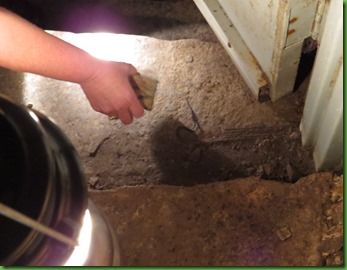


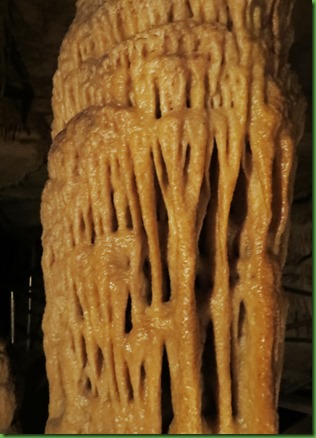

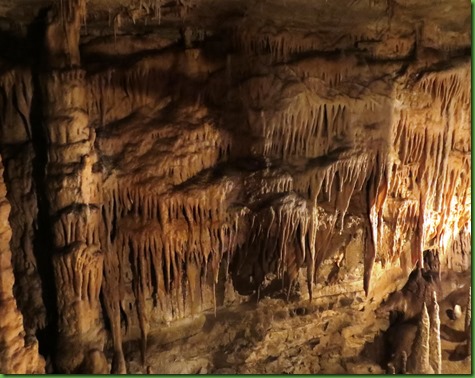

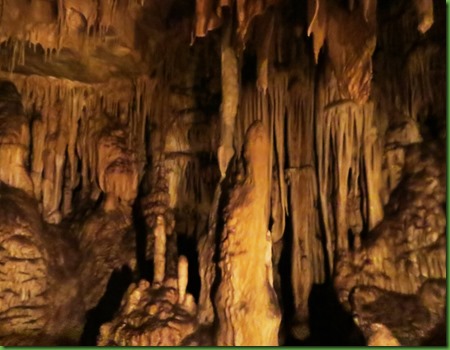









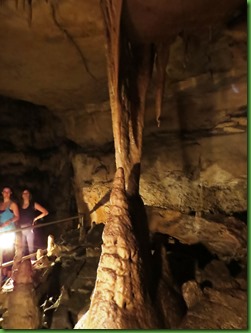


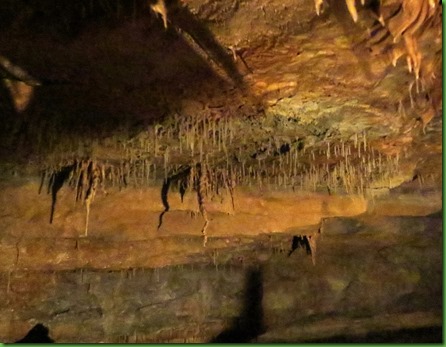
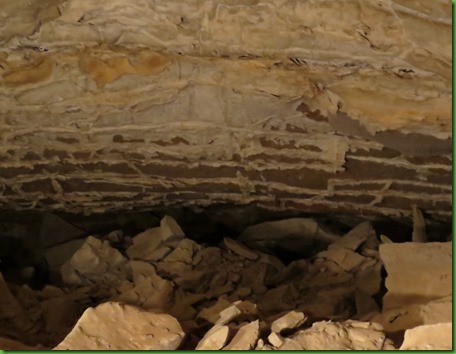













Never trust the word of a preacher simply because he (or she) is a preacher! Beautiful cave, although the big one at Mammoth Cave is still my favorite tour.
ReplyDeleteIt's far better that it's now in the hands of the parks service. It is achingly beautiful inside.
ReplyDeletePreacher or not, Edwards sounds like he was a vile, despicable man.
Neat cave story. Those gypsum formations are so delicate and beautiful! I think caves are always a great place to visit!
ReplyDeleteVery nice post on a very beautiful cave!! So glad that the caves are being cared for and kept as natural as possible. Would hate to see them destroyed by misuse!!
ReplyDeleteAnother great cave tour and history. I always carry a flashlight in my pocket:) I worked for the Fed govt for 30 years, and it turns out that self reliance is a good idea:)
ReplyDeleteYou are bringing back great memories!
ReplyDeleteThe "Hat" brings back memories of leading cave tours in OR. So glad the lanterns gave enough light for photos. I'd never heard of the cave war. Amazing what people will do for money. Thank goodness for Miss Lucy, and the Park Service. Superb formations. Great tour.
ReplyDeleteI've never been to that cave, but I sure would like to some time. I like the lantern idea better than the electric lights.
ReplyDeleteLooks like a great cave, added to the list.
ReplyDeleteNever saw a stalagmite soda bottle before... :cD
ReplyDeleteWhat an amazing tour!! The lantern light must have created the best effect. The columns and drapery are just gorgeous. I've never seen gypsum flowers...so cute. This is a magnificent cave. So glad they are limiting the visitations to preserve it. How nice you were there to get a tour:) Lucky you:)
ReplyDeleteWe did a similar tour with lanterns in Carlsbad in New Mexico. It was called the Rock of Ages tour and at the end the ranger sang this song as it echoed through the cave. It was a wonderful experience. You pictures are really good. We will certainly have to stop by soon.
ReplyDeleteMy mom was from western Kentucky - she told me the same story as to how to remember tites from mites, though yours is much simpler. Love the gypsum flowers.
ReplyDeleteoh goodness. . .could feel the claustrophobia just looking at the pics. . .glad you enjoyed it though!
ReplyDeleteSuch a beautiful place with a great history! Encouraging to see critters first thing in the door - and the continued growth within the cave. It seems the parks system has found a good balance of preservation and exposure/education for the cave following Lucy's stewardship. Thanks for all the photos and the wonderful information - I so enjoy them both Sherry!
ReplyDeleteGreat history lesson of this cave! I'm still amazed at what lies beneath our feet...
ReplyDeleteLooks like we'll have to head back to that area one fall. This is the way to learn history, thanks.
ReplyDeleteWow, what a great tour and you are so lucky to be on this lantern only tour. Another great history lesson, Sherry.
ReplyDeleteYou got great pics in the lantern light. Those and the wonderful story made for a very fun post. Thank You.
ReplyDeleteInteresting story. The lanterns are cool- can you imagine what it would have been like for the first explorers?
ReplyDeleteNever heard of the cave wars. Have passed Mammoth Cave many times - will have to plan to stop next time to see both Mammoth and Onyx. Thanks for the post and the pictures. Very nice
ReplyDeleteHmmm….I think my comment disappeared. Anyway, I was thinking how crazy it is to have a cave war as I was reading your interesting historical account. Avarice knows no bounds! Beautiful formations, and how wonderful that you were able to take the lantern tour.
ReplyDeletePretty amazing pictures, Sherry. I felt like I was right there! Excellent!!!
ReplyDeleteVirtual hugs,
Judie
Beautiful pictures ... love the gypsum flowers. Interesting war stories...Edwards was not a nice man :( I do recall a case with that holding in law school. I think the lower court Kentucky case was definitely one of first impression at the time. I'm so glad Great Onyx is so well preserved and you got to see it! :)
ReplyDelete